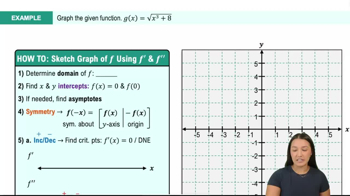Table of contents
- 0. Functions7h 52m
- Introduction to Functions16m
- Piecewise Functions10m
- Properties of Functions9m
- Common Functions1h 8m
- Transformations5m
- Combining Functions27m
- Exponent rules32m
- Exponential Functions28m
- Logarithmic Functions24m
- Properties of Logarithms34m
- Exponential & Logarithmic Equations35m
- Introduction to Trigonometric Functions38m
- Graphs of Trigonometric Functions44m
- Trigonometric Identities47m
- Inverse Trigonometric Functions48m
- 1. Limits and Continuity2h 2m
- 2. Intro to Derivatives1h 33m
- 3. Techniques of Differentiation3h 18m
- 4. Applications of Derivatives2h 38m
- 5. Graphical Applications of Derivatives6h 2m
- 6. Derivatives of Inverse, Exponential, & Logarithmic Functions2h 37m
- 7. Antiderivatives & Indefinite Integrals1h 26m
- 8. Definite Integrals3h 25m
5. Graphical Applications of Derivatives
Curve Sketching
Problem 5d
Textbook Question
Use the graphs of ƒ' and ƒ" to complete the following steps. <IMAGE>
Plot a possible graph of f.
 Verified step by step guidance
Verified step by step guidance1
Analyze the graph of ƒ' to determine where the function f is increasing or decreasing. Look for intervals where ƒ' is positive (f is increasing) and where ƒ' is negative (f is decreasing).
Identify the critical points of f by finding where ƒ' crosses the x-axis, as these points indicate potential local maxima or minima.
Examine the graph of ƒ'' to determine the concavity of f. If ƒ'' is positive, f is concave up; if ƒ'' is negative, f is concave down.
Use the information from ƒ' and ƒ'' to sketch the general shape of the graph of f, marking the critical points and indicating intervals of increase/decrease and concavity.
Combine all the information to create a smooth curve that reflects the behavior indicated by the graphs of ƒ' and ƒ'', ensuring to label key features such as local maxima, minima, and points of inflection.
Was this helpful?

 11:41m
11:41mWatch next
Master Summary of Curve Sketching with a bite sized video explanation from Callie
Start learning




